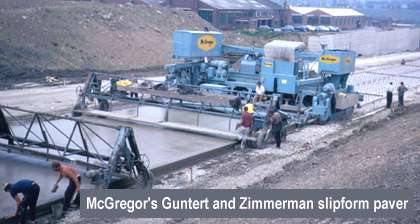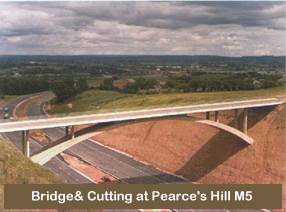The M5 in the South Western Region
List of material held by the Somerset Archive and Record Service
The full archive for this scheme is stored at:
The County Archivist, Somerset Archive and Record Office, Obridge Road, Taunton, Somerset TA2 7PU
Level: Collection Access: Open. Its accession number is: M/582 Catalogue reference: A/BXB
The Office may be contacted by phone on 01823 278805, by fax on 01823 325402, or by Email
| A\BXB/2 | M5 Motorway | |
| A\BXB/2/1 | Official papers and reports | |
| A\BXB/2/1/1 | 1969 | Copy of the South Western Road Construction Unit Programme issued December 1969. (1 document) |
| A\BXB/2/1/2 | 1977 | Report of a working party of the Department of Transport entitled, 'Route Location with Regard to Environmental Issues'. (1 document) |
| A\BXB/2/1/3 | 1979 | Pamphlet entitled, 'Trunk Road Proposals - A Comprehensive Framework for Appraisal'. Prepared by The Standing Advisory Committee on Trunk Road Assessment. (1 document) |
| A\BXB/2/1/4 | 1974-1975 | Copy of the Department of the Environment South Western Road Construction Units 7th Annual Report. (1 document) |
| A\BXB/2/2 | Pamphlets and opening brochures | |
| A\BXB/2/2/1 | 1973 | Pamphlets entitled, 'M5 Motorway in Gloucestershire and Somerset. Prepared by Consulting Engineers Freeman Fox and Partners to mark the completion of the M5 as far as Edithmead. Includes an earlier draft version. (6 documents) |
| A\BXIB/2/2/2 | 1971 | Opening brochure for the Gloucester-Cheltenham section of the M5 in March 1971. (1 document) |
| A\BXB/2/2/3 | 1969 | Opening brochure for the Avonmouth section of the M5 in August 1969. (1 document) |
| A\BXB/2/2/4 | 972 | Opening brochures for the Avonmouth Bridge section of the M5 in August 1972. (2 documents) |
| A\BXB/2/2/5 | 1973 | Opening brochures for the Dunball to Huntworth section of the M5. This was opened on the 18th Dec 1973 by the Rt. Hon. John Peyton, Minister for Transport Industries. (2 documents) |
| A\BXB/2/2/6 | 1976 | Opening brochure for the Chelston to Willand section of the M5 in October 1976. (1 document) |
| A\BXB/2/2/7 | 1977. | Opening brochure marking the completion of the M5 upon the opening of the Exminster section by the Prime Minister the Rt. Hon. James Callaghan MP on 27th May 1977. The brochure contains information about the whole of the M5 from Strensham, Worcestershire to Pearces Hill, Devon and includes a separate sheet listing those who were presented to the Prime Minister. (1 document) |
| A\BXB/2/2/8 | 1970 | Copies of a pamphlet issued to members of the South Western Association of the Institution of Civil Engineers, who attended a visit to view motorway construction in the South West on the 10th September 1970. One copy includes the address of welcome from the Director of the Southwestern Road Construction Unit, Mr P G Lyth. (2 documents) |
| A\BXB/2/2/9 | 1972 | Pamphlet issued to members of the South Western branch of the Institution of Highway Engineers on the occasion of their visit to view construction works on the Edithmead to Dunball and Dunball to Huntworth sections of the M5 on the 27th September 1972. (1 document) |
| A\BXB/2/2/10 | 1973 | Pamphlet issued to members of the South Western branch of the Institution of Highway Engineers on the occasion of their visit to view construction works on the Blackbrook to Chelston section of the M5 on the 25th July 1973. (1 document) |
| A\BXB/2/2/11 | n.d [c.1974] | A pamphlet prepared for the proposed Pearces Hill to Pocombe Link Road A30. (1 document) |
| A\BXB/2/2/12 | n.d | Copies of a paper entitled, M5 Motorway in Devon'. (4 documents) |
| A\BXB/2/2/13 | n.d [c.1970s] | An extract from the magazine New Civil Engineer about the Avonmouth Bridge and a publicity paper by the contractor Fairfield Mabey. (2 documents) |
| A\BXB/2/2/14 | c.1973 | An article about the construction of the M5 from the Avonmouth Bridge to Dunball. (1 document) |
| A\BXB/2/2/15 | 1973 | An article from Construction News about the construction of the M5 from the Avonmouth Bridge to Dunball. (1 document) |
| A\BXB/2/2/16 | c.1973 | Extract from a magazine concerning the Edithmead to Dunball section of the M5. (1 document) |
| A\BXB/2/2/17 | 1971 | Copy of the Proceedings of the Institution of Civil Engineers entitled, 'Design and construction of embankments on analluvial plain', by N J Dallard. (1 document) |
| A\BXB/2/2/18 | 1972 | Copy of the Proceedings of the Institution of Civil Engineers with a discussion on A\BXB/2/2/17. (1 document) |
| A\BXB/2/2/19 | 1972 | A report prepared by Devon County Council entitled, 'The Motorway Into Devon: The Challenge'. (1 document) |
| A\BXB/2/2/20 | c.1990s | Chapter 3 from a book by Michael Hawkins, the former County Engineer of Devon, which refers to the M5. (1 document) |
| A\BXB/2/2/21 | n.d | Copies of a map of the M5 motorway from Strensharn to Edithmead, prepared by Freeman Fox and Partners. (2 documents) |
| A\BXB/2/2/22 | n.d | Map of the M5 motorway from Avonmouth to Puriton. (1 document) |
| A\BXB/2/2/23 | n.d | Map of the M5 motorway fromEdithmead to Willand. (1 document) |
| A\BXB/2/2/24 | n.d | Map of the M5 motorway fromEdithmead to the West of Exeter alternative routes. (1 document) |
| A\BXB/2/3 | Recollections andcorrespondence | |
| ASXB/2/3/1 | 1999 | Letter to F D J Johnson from Brigadier Stanley Baldwin containing his personal recollections. (1 document) |
| A\BXB/2/3/2 | 1994 | A paper entitled, 'Bridging the Gaps', by Michael Clerk, a former section engineer in the RCU HQ. (1 document) |
| A\BXB/2/3/3 | 1998 | Two letters from Professor R Bridle suggesting sources of material for the Motorway Archive project, together with anecdotal memories. (2 documents) |
| A\BXB/2/4 | Newspaper cuttings | |
| A\BXB/2/4/1 | 1967 | Copy article on the M5 from the magazine Roads and Road Construction. (1 document) |
| A\BXB/2/4/2 | 1967 | Newspaper cutting on the M5 from the Western Daily Press (1 document) |
| A\BXB/2/4/3 | 1967 | Copy newspaper cutting on the M5 from the Cheddar Valley Gazette. (1 document) |
| A\BXB/2/4/4 | 1977 | Newspaper cutting about the Exminster section of the M5. (1 document) |
| A\BXB/2/5 | Photographs | |
| A\BXB/2/5/1 | 1974 83 | photographic prints (mostly black and white) of various sections of the M5 Motorway. (1 bundle) |
| A\BXB/2/5/2 | 1971-1972 | 11 mounted photographs of the M5 motorway under construction and once completed. (11 documents) |
| A\BXB/2/5/3 | n.d [c. 1970] |
4 photographs of artistic representations of proposed bridges on the M5 Motorway. (4 documents) |
| A\BXB/3 | Papers of the Trust | |
| A\BXB/3/1 | 2002 | Executive summary report of the Motorway Archive Trust project. The report was compiled by F D J Johnson, former County Surveyor of Somerset and former President of the County Surveyors Society. It provides a history and context to the construction of a motorway network in South West England. (1 document) |



